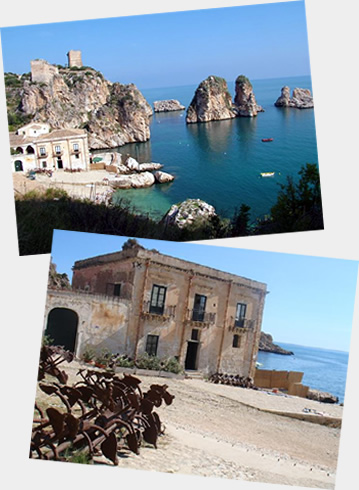The "Tonnare"
 The best starting point for the discovery of Western Sicily's Tonnare is of course the Genovese Cave, in Levanzo, where Neolithic paintings show human and animal images: among these, tunas can be easily observed, as an evidence of the historical tradition of tuna fishing.
The best starting point for the discovery of Western Sicily's Tonnare is of course the Genovese Cave, in Levanzo, where Neolithic paintings show human and animal images: among these, tunas can be easily observed, as an evidence of the historical tradition of tuna fishing.
The Mediterranean area, thanks to its mild climate and a sea temperature of around 18 degrees in the month of May, is the best place for the breeding of tunas that, entering from the Gibraltar Strait, come to couple near the Sicilian coastline.
The Trapani province is rich in Tonnare, but the most beautiful, interesting and totally worth visiting are in Favignana and Scopello. The Tonnara of Favignana, recently restored, used to be one of the biggest, top-level food industry complex in the whole Europe, successfully competing with the most important foreign industries.
The Tonnara of Favignana belonged to the Florio family and used to ensure a high level of affluence to many families; old people from the village still miss the times of the butchery, the "mattanza" (from latin "mactare", to kill), of tunas. This operation was supported by ancient songs and a complex fishing system deriving from the Arabs. Once the tunas were collected on the ships, they were taken to the factory and the fish started being processed (evisceration, cleaning, boiling, in-oil conservation), then canned and sold throughout the whole Europe. Today, it is possible to visit the ancient factory: a fascinating place evoking an ancient atmosphere, with history, pictures and videos.
The Tonnara of Scopello (near Castellammare del Golfo) is smaller, but as much fascinating as the one in Favignana. First of all, it is set in an enchanting location: "faraglioni", huge dramatic rocks with luxurious vegetation and a crystal sea full of fish are the background of what used to be one of the main local activities. The silence surrounding the Tonnara, broken only by the gentle sound of the waves, will let you "hear" the voices of the "tonnaroti", as they were singing and praying for a wealthy fishing day.
Warehouses with ancient boats are still undamaged among these, the monumental "palascarmi" and the Rais' "muciara" (big ship), as well as the nets storage house, while along the buildings' walls we can see almost 300 well-preserved anchors.